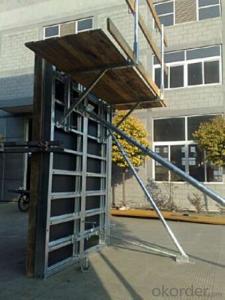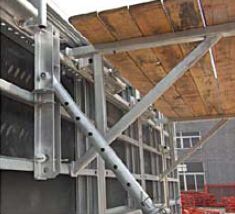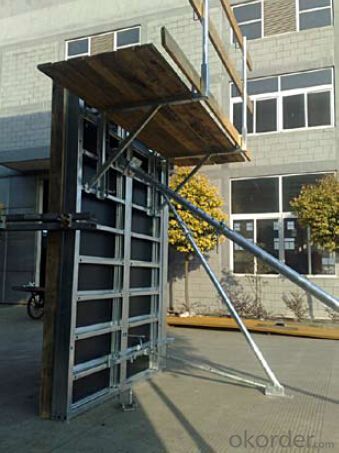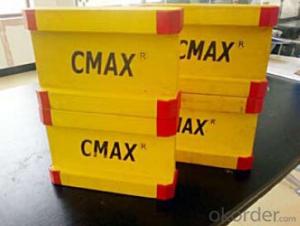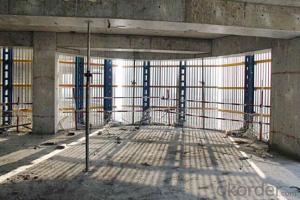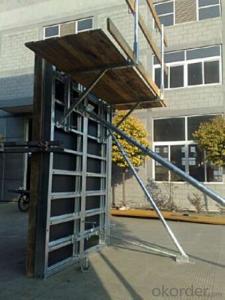Steel-frame Formwork and scaffolding system platform
- Loading Port:
- Tianjin
- Payment Terms:
- TT OR LC
- Min Order Qty:
- 50 m²
- Supply Capability:
- 1000 m²/month
OKorder Service Pledge
OKorder Financial Service
You Might Also Like
Steel-frame Formwork SF-140
Characteristics:
◆ Few parts for fast forming.
◆ Max. Concrete pressure: 80KN/m2.
◆ Hot-dip galvanized steel frame.
◆ The thickness of plywood is 18mm & the panel is 14cm.
◆ Compatibility with Hunnebeck Manto system due to similar edge profile.
System Details & Application:
◆ Neat joint and fast assembling with aligning panel clamp.
◆ Flexible panel arrangement and height extension.
◆ The selection of panels.
◆ Kinds of panel connectors.
◆ Corner clamp application.
◆ Length adjustment application.
◆ Height adjustment & aligning strut.
◆ Walkway bracket & platform.
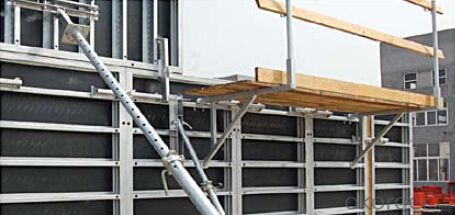
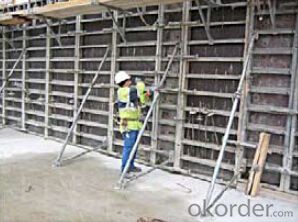
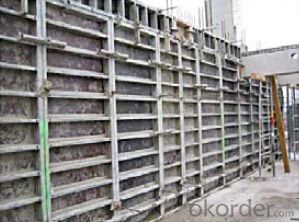
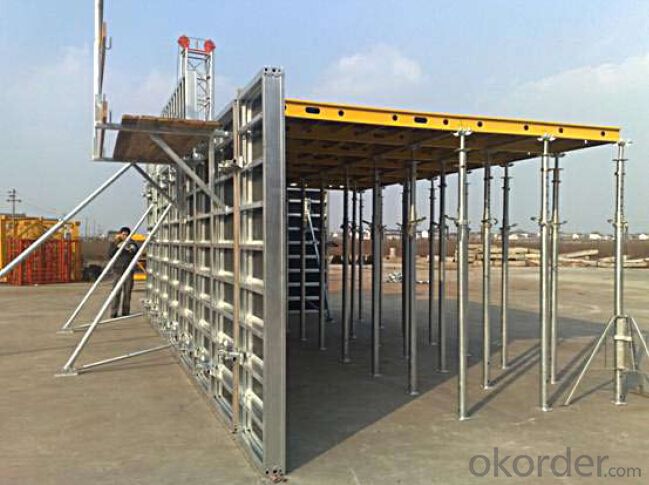
- Q: Can steel formwork be used for both standard and non-standard concrete shapes?
- Yes, steel formwork can be used for both standard and non-standard concrete shapes. Steel is a versatile material that can be easily molded and shaped to create various formwork designs. It offers high strength and durability, making it suitable for complex and intricate concrete shapes. Steel formwork can be fabricated to meet specific project requirements, allowing for customization and flexibility in formwork design. Whether it is a standard rectangular shape or a unique and irregular design, steel formwork can be used effectively to mold and shape concrete structures of any shape and size.
- Q: How does steel formwork affect the overall cost of concrete placement?
- The overall cost of concrete placement can be significantly affected by steel formwork. Although the initial cost of steel formwork may be higher compared to other types of formwork, it offers several advantages that can result in long-term cost savings. To begin with, steel formwork is durable and can be reused multiple times, unlike traditional wooden formwork that often requires replacement after a few uses. This reusability reduces the need to purchase new formwork for each concrete placement, resulting in cost savings over time. Furthermore, steel formwork provides a smooth and consistent finish to the concrete surface, reducing the need for extensive surface preparation and finishing work. This can decrease labor costs and save time during the concrete placement process. Moreover, steel formwork offers better structural stability, ensuring a higher quality concrete placement with minimal defects. This reduces the risk of expensive rework or repairs, thereby saving money in the long term. Additionally, steel formwork allows for a faster construction process due to its easy assembly and disassembly. This can lead to reduced labor costs and increased productivity, ultimately resulting in lower overall construction expenses. Lastly, steel formwork is highly resistant to moisture and weather conditions, reducing the risk of damage and increasing its lifespan. This durability translates to long-term cost savings as frequent replacements or repairs are not necessary. In conclusion, despite the higher initial investment, the durability, reusability, superior finish, structural stability, construction speed, and resistance to damage make steel formwork a cost-effective choice for concrete placement. The long-term savings in labor, materials, and repairs outweigh the initial cost, making steel formwork a wise investment for construction projects.
- Q: How are steel formwork panels connected together?
- Steel formwork panels are connected together through a variety of methods to create a strong and stable structure for concrete pouring. One common method is the use of steel pins or bolts, which are inserted into pre-drilled holes in the panels. These pins or bolts are then tightened or fastened with nuts, ensuring a secure connection between the panels. Another method is through the use of clamps or couplers, which are placed around the edges of the panels and tightened to hold them together. These clamps or couplers can be easily adjusted or removed, allowing for flexibility in the formwork system. Additionally, some steel formwork panels feature interlocking mechanisms, such as slots or hooks, that enable them to be easily aligned and connected. These interlocking features provide a seamless connection between the panels, creating a smooth and continuous surface for concrete placement. Overall, the connection of steel formwork panels is crucial for maintaining the integrity and stability of the formwork system during the concrete pouring process. The chosen method of connection will depend on the specific design and requirements of the project, as well as the type of steel formwork being used.
- Q: Can steel formwork be used for both horizontal and vertical construction elements?
- Indeed, steel formwork proves to be applicable for both horizontal and vertical construction components. With its versatility and durability, steel formwork emerges as a flexible and long-lasting alternative for constructing concrete structures. It boasts easy adjustability and assembly, enabling it to accommodate diverse shapes and sizes, rendering it suitable for both horizontal components such as slabs and beams, as well as vertical components like walls and columns. By providing exceptional support and stability during the concrete pouring stage, steel formwork guarantees the attainment of desired shapes and finishes for construction components. Furthermore, the ability to reuse steel formwork multiple times renders it an economically sound option for construction projects.
- Q: How does steel formwork prevent concrete shrinkage and cracking?
- The use of steel formwork is essential in preventing concrete shrinkage and cracking. By offering robust and rigid support during the curing process, it ensures that the concrete retains its shape and hardens properly. Acting as a mold, the steel formwork securely holds the concrete in place, preventing any shrinkage or cracking as it dries. Concrete shrinkage and cracking are primarily caused by the loss of moisture during curing. As the water evaporates from the concrete, it causes the material to shrink, potentially leading to cracks if not adequately supported. To prevent this shrinkage, steel formwork provides a tight enclosure for the concrete, ensuring that it retains its moisture and doesn't dry out too quickly. This controlled drying process allows for even curing, minimizing the risk of shrinkage and cracking. Moreover, steel formwork provides stability and support to the concrete, preventing any movement or shifting as it hardens. This stability helps distribute forces and stresses evenly, reducing the likelihood of cracking or structural failure. Furthermore, the smooth and rigid surface of steel formwork contributes to achieving a high-quality finish on the concrete. This eliminates any irregularities or imperfections that may weaken the structure or make it more susceptible to cracking. In conclusion, steel formwork is vital in preventing concrete shrinkage and cracking by offering support, stability, and moisture retention during the curing process. Its strong and rigid structure ensures the integrity of the concrete and enhances its durability, reducing the risk of structural issues.
- Q: How does steel formwork contribute to the overall fire safety of the building?
- Steel formwork contributes to the overall fire safety of the building in several ways. Firstly, steel is a non-combustible material, meaning it does not burn or contribute to the spread of fire. This helps to minimize the risk of fire spread and containment breaches within the structure. Additionally, steel formwork provides structural stability and strength, which is crucial during a fire event as it helps to maintain the integrity of the building and prevents structural collapse. Steel also has a high melting point, allowing it to withstand high temperatures for longer periods before it weakens, providing additional time for evacuation and firefighting efforts. Overall, the use of steel formwork enhances the fire resistance of the building, ensuring the safety of occupants and minimizing potential damage.
- Q: What are the common connection methods for steel formwork?
- The common connection methods for steel formwork include welding, bolting, and clamping. Welding is a popular method as it offers strong and permanent connections. It involves melting two steel components together to create a bond. However, welding requires skilled labor and specialized equipment. Bolting is another commonly used connection method for steel formwork. This method involves using bolts and nuts to join the steel components together. Bolting offers a flexible and adjustable connection, allowing for easy disassembly and reassembly of formwork panels. It is also a relatively quick method and does not require highly skilled labor. Clamping is a connection method that utilizes clamps or couplers to connect steel formwork components. This method is often used for temporary formwork structures or when quick assembly and disassembly are required. Clamping offers a flexible and adjustable connection, similar to bolting, but without the need for tools or additional hardware. Overall, the choice of connection method for steel formwork depends on various factors such as the project requirements, desired level of permanence, ease of assembly, and available resources. Each method has its advantages and disadvantages, and it is important to select the most suitable method based on the specific project needs.
- Q: What are the considerations when designing steel formwork for bridges?
- When designing steel formwork for bridges, there are several considerations to take into account. Firstly, the load capacity of the formwork must be determined, ensuring that it can support the weight of the wet concrete and any construction equipment. Additionally, the formwork should be designed to withstand the forces generated during the pouring and curing of the concrete, such as lateral pressure and vibration. The formwork system should also be easy to assemble, disassemble, and adjust to accommodate different bridge geometries and dimensions. It is important to consider the durability and corrosion resistance of the steel used in the formwork, as bridges are often exposed to harsh environmental conditions. Finally, the design should incorporate safety measures, such as guardrails and access platforms, to ensure the safety of workers during construction.
- Q: What are the different accessories required for steel formwork maintenance?
- Some of the different accessories required for steel formwork maintenance include formwork release agents, cleaning solutions, wire brushes, repair materials such as epoxy or cementitious grout, lubricants for hinges and pins, and protective coatings for corrosion prevention. Additionally, tools such as hammers, wrenches, and pliers may be needed for minor repairs or adjustments.
- Q: Can steel formwork be used for curved or irregularly shaped structures?
- Curved or irregularly shaped structures can definitely utilize steel formwork. Unlike traditional wood formwork, steel formwork offers greater flexibility and can effortlessly conform to any desired curve or irregular shape. This renders it a perfect option for constructing structures with distinctive architectural designs or intricate geometries. Furthermore, steel formwork boasts exceptional strength and durability, guaranteeing its ability to endure the pressures exerted during the concrete pouring process and retain its shape throughout the construction phase. All in all, steel formwork presents a versatile and dependable solution for shaping curved or irregularly shaped structures.
Send your message to us
Steel-frame Formwork and scaffolding system platform
- Loading Port:
- Tianjin
- Payment Terms:
- TT OR LC
- Min Order Qty:
- 50 m²
- Supply Capability:
- 1000 m²/month
OKorder Service Pledge
OKorder Financial Service
Similar products
Hot products
Hot Searches
Related keywords

